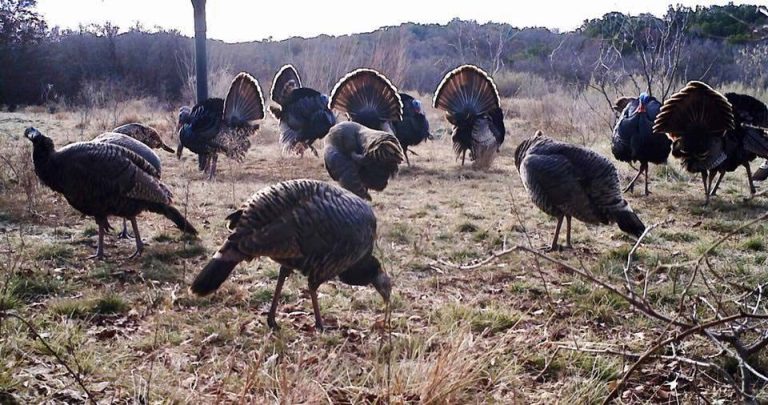Photos by Luke Clayton
Spring is to turkey hunters what Christmas morning is to a ten year old. The majority of turkey hunters longingly await the spring breeding season when gobblers are sounding off and for the opportunity to once again hit the turkey woods. I too am a devout hunter of spring turkeys when the sounds of ‘turkey love’ fills the woods and fields in the form of plaintive hen yelps, purrs and cuts and then, that pulse quickening gobble that I just know is a boss gobbler back in the brush or just across the creek with beard dragging the ground.
By the time fall hunting seasons rolls around, my supply of wild turkey in the freezer is long gone and it’s time to do a bit of ‘shopping’ in the wild! Once you have enjoyed a slow smoked or roasted fat ten pound hen or 8 pound poult, that Butterball will forever be a second choice for the centerpiece of your Thanksgiving dinner. For many years, I have looked forward to setting up one of my pop up blinds in good turkey country during archery season in the fall and attempting to entice a big gobbler or hen within bow range. Yes, I did say hen! In Texas and most states hen turkeys are legal to hunt it the fall and to my way to thinking, the fall season perfectly coincides with a fine Thanksgiving dinner of freshly harvest wild turkey, just the way the Pilgrims did it!
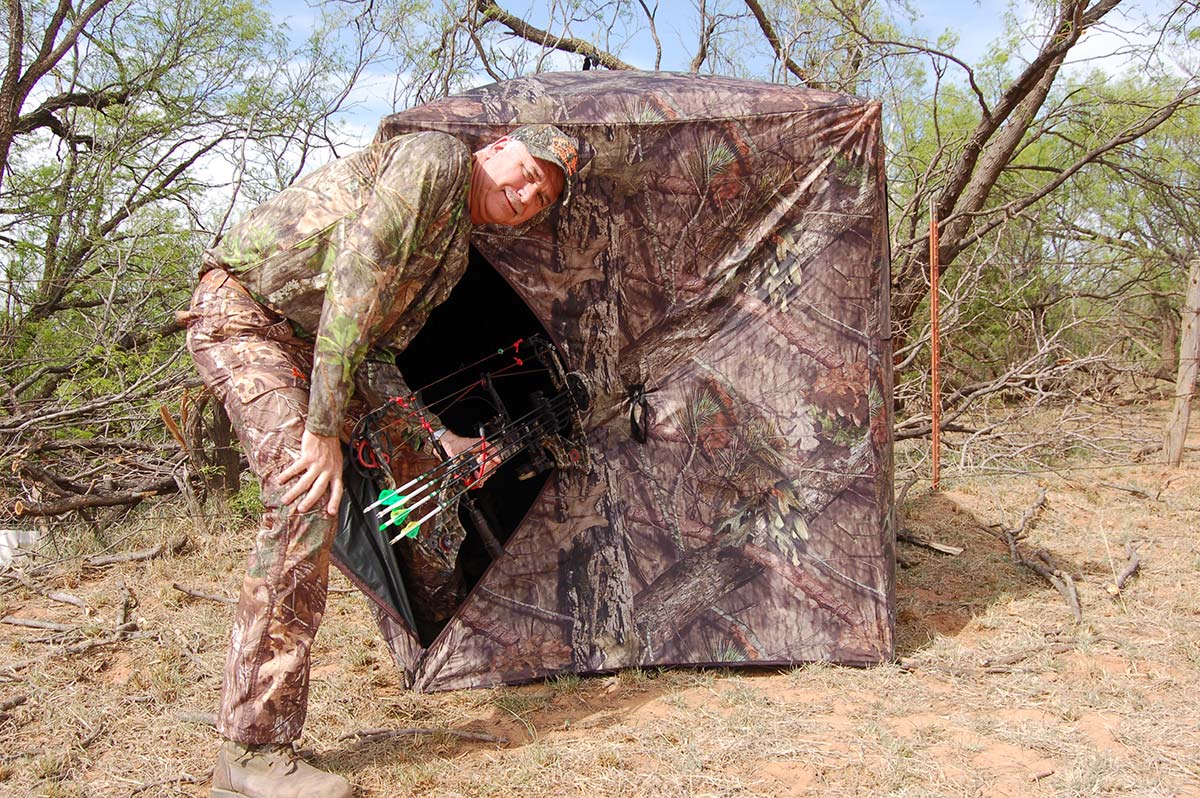
Bag limit is a total of 4 turkeys per year in Texas where I do most of my hunting, either sex but hens can only be hunted in the fall in select counties. Spring hunting is for gobblers only, statewide. In the spring, I am all about enticing a mature longbeard within shooting range but when procuring my Thanksgiving turkey from the wilds in the fall, a hen or possibly two hens is just fine, depending upon how many turkey tags are left on my hunting license and which sex gives me a good broadside shot at reasonable close range.
We bowhunters obviously have to get close, usually within 30 yards and movement is obviously necessary when drawing a bow. While it’s possible to arrow a fall turkey by using natural vegetation as cover, I’ve found it much easier to hunt from a pop up blind or one of the quick set up umbrella type blinds that basically conceal one from the area out if front of the blind. I’ve had success with this type blind but found it necessary to remain statue still when birds are approaching from the rear, which is often the case after a flock is flushed and you are attempting to call them back together. A light easy to set up blind is very handy but to my way of thinking nothing beats the concealment offered by a pop up blind. I do most of my fall turkey hunting around feeding area, sometimes feeders but when acorns or fall crops are on the ground, I go where the turkeys are. In Texas and across much of the country, most ranches or farms where hunting occurs has multiple corn feeders. Turkeys make their rounds in the fall from one feeder to the other and setting up a blind with decoy near these feeding hot spots can often produce action.
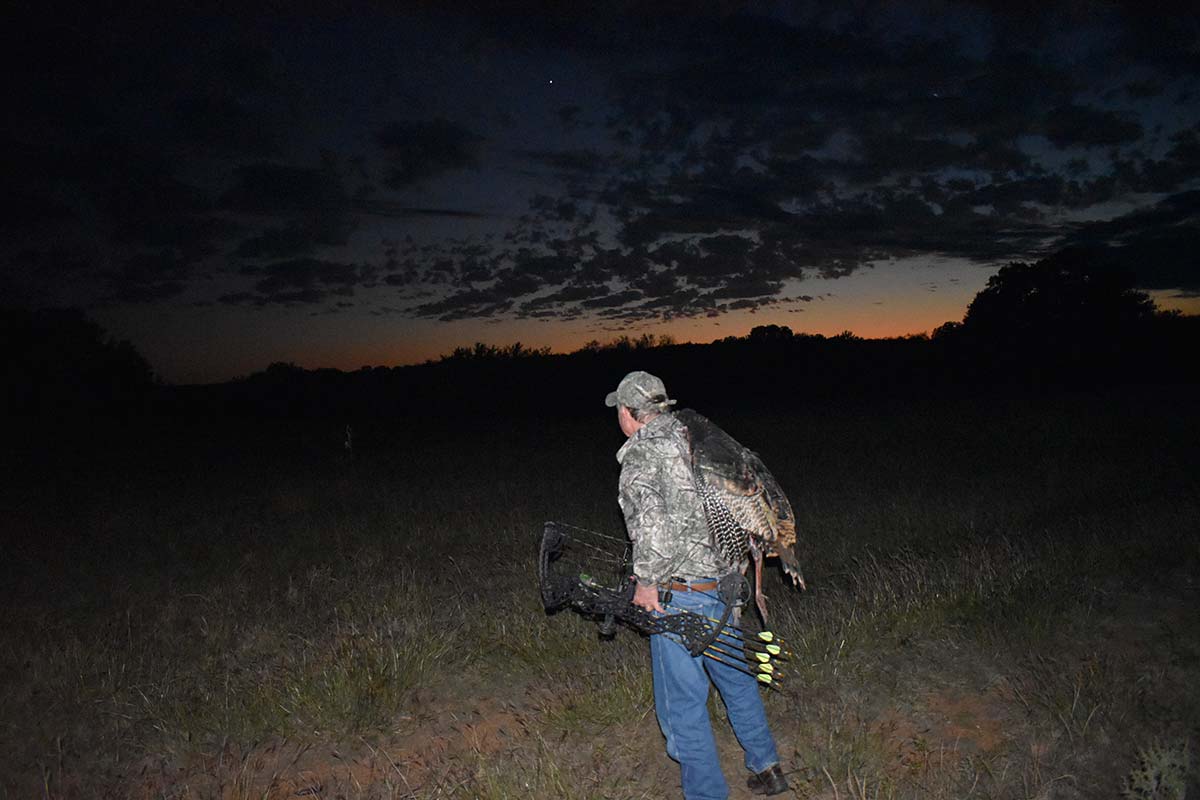
While decoys aren’t as helpful as during the spring, I do think the sight of a single decoy often causes a lone bird or sometimes and entire flock to come in for a closer look. Lead hens are especially attracted to loud aggressive hen sounds; the kee-lee run is usually the most effectve. The sound of another ‘boss hen’ in the area often gets the old gal’s feathers ruffled and she will move in with her accompanying flock for a closer inspection. Just like with other wildlife species such as wild hogs, deer and waterfowl, it’s usually a mature female that runs the show and this is especially so with turkey flocks. In the fall, it’s common for mixed flocks of poults from the spring hatch, jakes and gobblers to group together which often makes it challenging for the bow hunter to drew and make the shot without detection. It can be tough to dupe a single gobbler in the spring but fooling a flock of turkey within bow range is especially challenging. This is the primary reason I prefer an enclosed blind of some sort. Hens can often be called in with a plaintive ‘lost hen yelp’. For the past several months hen turkeys have depended upon sound to keep their poults together and sound of a lone bird brings out the maternal instinct in a hen. Very often she will head toward that ‘lost’ bird, bringing a flock with her.
Head shots on turkeys has been in the limelight in outdoor press for the past decade or so. A big, wide mechanical broad head perfectly centered on the neck is extremely deadly and does eliminate a tracking job but the placement has to be spot on. A turkey’s head is seldom still for very long. I much prefer a broadside shot with point of aim being slightly below where the wing joins the body. Turkeys are tough birds and I guesstimate at least half of the turkeys I’ve killed have ran at least 20 yards after the shot, sometimes farther even with a well placed shot. It’s important to keep an eye on the direction the bird runs. Turkeys leave a very sparse blood trail, if one at all and recovery can be challenging in heavy vegetation.
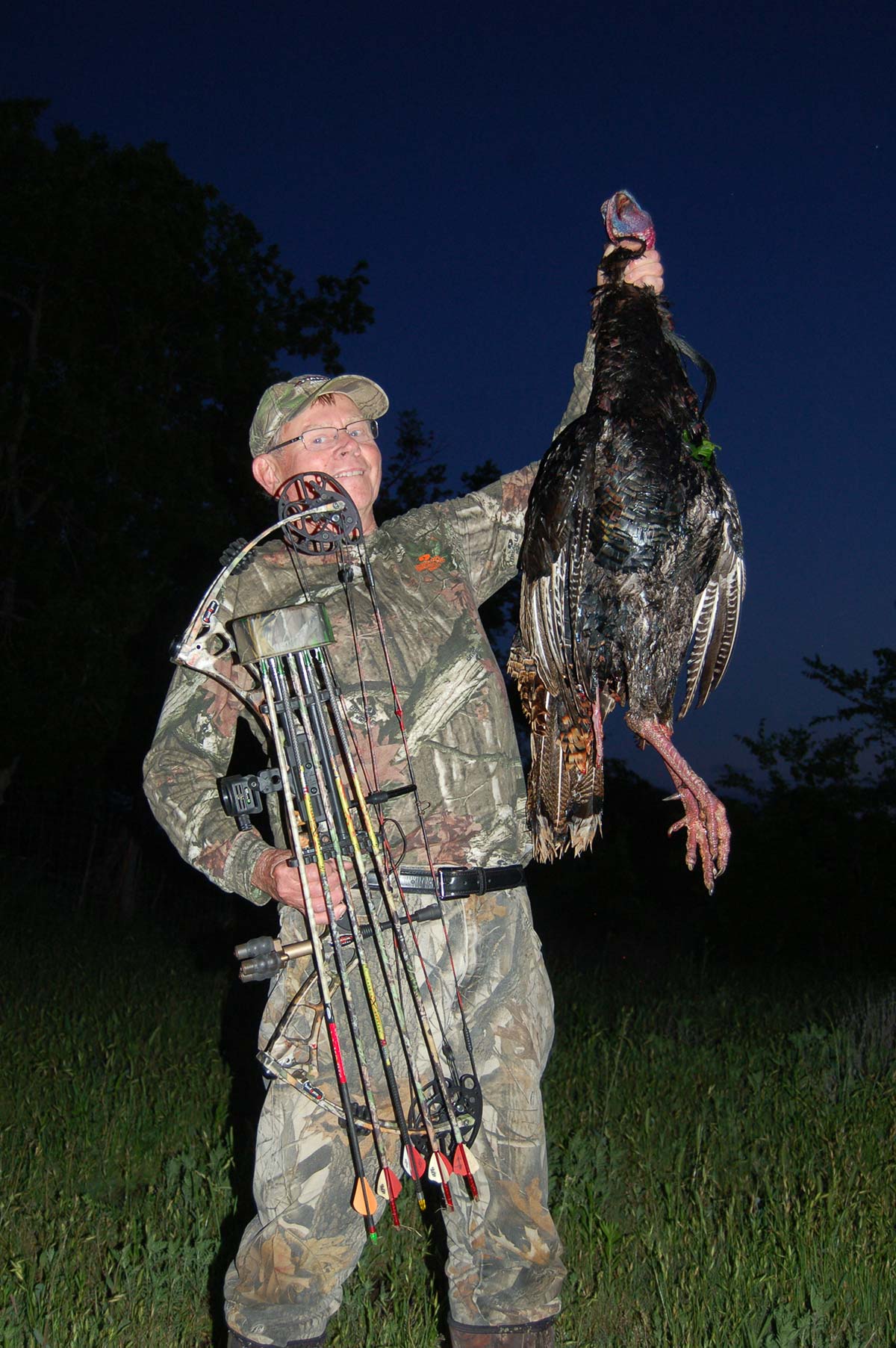
There is a long standing debate between fixed broad heads or mechanicals for turkey hunting. While a body shot outside the heart/lungs will eventually end in the demise of a turkey, following up after the shot is extremely trough. “Tracking” a wounded turkey often results in a lost bird because of the sparse blood trail. For many years, I’ve use mechanical broad heads. There are many excellent mechanicals on the market but I’ve found Innerlock three blade mechanicals that open on contact to a full 2 inches cutting diameter to be extremely effective. The added cutting diameter of mechanicals is an added bonus when targeting the relatively small heart/lung region. I consider the added third blade a bonus, especially on a marginally placed shot.
Scouting is important regardless our quarry but especially so when hunting fall turkey. At times, there will be large concentrations of birds on food plots but when the acorns begin to drop, the action might move to hardwood ridges. Unless we live in turkey country, it’s best to spend time with some binocs scouting fields and walking the woods calling in order to locate the birds. Once there location is detected, it’s time to move out and set up a blind in the area. This plan makes far more sense than simply setting a blind in an area that looks good. Find the food and you will find the turkeys, especially during the fall. They sense winter is coming on and feed heavily in the fall. Early in the season, depending upon which state you’re hunting, grasshoppers might still be in abundance. Turkeys favor grasshoppers over all other insects, probably because they instinctively know they are such a great protein source.
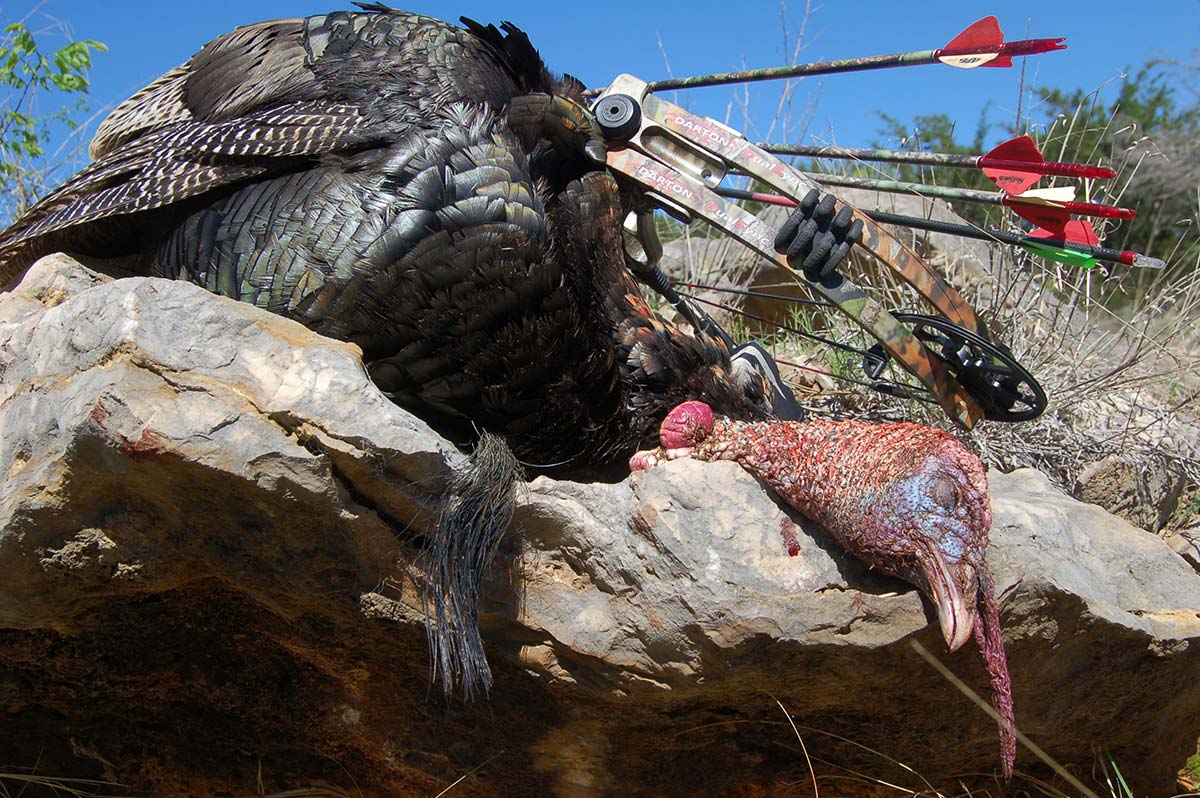
Hunting around roosts is also highly effective. If you get out late in the afternoon and locate roost sites, you know where you will find the birds at first light. A good plan is to slip in well before sunup, quietly set up your blind and possibly set a decoy or two out in front. When the birds fly down and mill around a few minutes, sorting out their route of travel, you can possibly call softly and entice one or more within bow range.
When you stop and think about it, fall turkey hunting is not all that different from spring hunting during the breeding season. The gobblers will still sound off occasionally, at least enough to let you know their location. Fall hunting might even be considered a higher percentage hunt. Rather than looking for a single bird coming in to your set up, you will find you have multiple targets to choose from. Getting them to stand still long enough for the shot before spooking will be the challenge!
Per our affiliate disclosure, we may earn revenue from the products available on this page. To learn more about how we test gear, click here.





